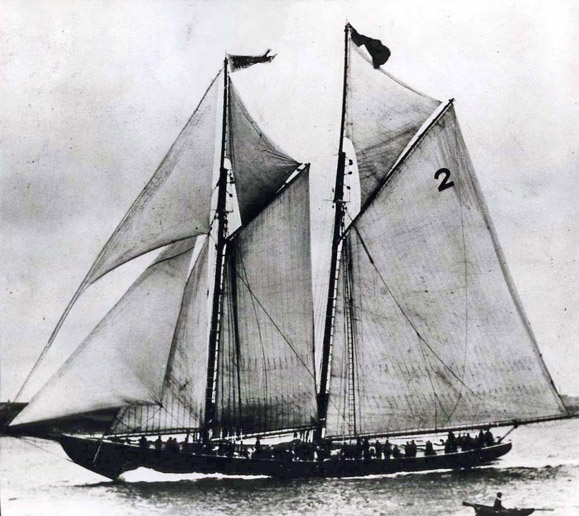Hall of Famer
The Bluenose
Inducted in 1955
Member Details
Career Highlights
Undefeated champion of International Fisherman's Trophy race
Sold to West Indian trading company
Wrecked off the coast of Haiti

Story
Even though her frame is draped in sails instead of flesh, the Bluenose was as much a Canadian icon as any human being. Unparalleled in her speed, elegance, and mystique, the Bluenose came to symbolize the prosperous Canadian seafaring life of the early part of the 20th century. With Captain Angus Walters at the helm, the Bluenose was the undefeated champion of the International Fisherman's Trophy competition, with the exception of one race which was deemed unofficial due to a technical infraction. In 1920, Halifax Herald owner W.H. Dennis decided to settle the rivalry that existed between Nova Scotia and New England fisherman with the creation of the International Fisherman's Trophy, an award that was to be bestowed upon the fastest fishing vessel along with a cash prize of $4,000. Designed by William J. Roué, a young Halifax naval architect, and built by the Smith and Rhuland shipping company of Lunenburg, the Bluenose was born with the honour and prestige of this trophy in mind. Captain Angus Walters, a fiery fisherman from Lunenburg, was selected as her skipper. He breathed life into her sails, and together they took the North Atlantic by storm. Under Walters' able hand, this speedy fishing schooner soon proved that she was not only seaworthy but a natural nautical champion. The Bluenose won her first International Fisherman's Trophy in the fall of 1921 when she defeated Captain Marty Welch's Elsie. The following year she was victorious once again, this time over the Henry Ford. In 1923, the Bluenose met its next American rival, the Columbia. During the first race, bad blood began to boil when Columbia's Captain Ben Pine forced Captain Walters and his ship into shallow waters. Walters was still able to pull ahead and cross the finish line, but in order to avoid a recurrence, officials passed a ruling prohibiting skippers from coming inshore of the buoys. In the second race, Captain Walters sailed past the buoy line, this time on purpose, and took the lead once more. Captain Pine protested, and officials awarded the victory to the American vessel. In outrage, Walters argued that the Bluenose had sailed over just as much water as the Columbia. So much controversy ensued that the whole event was deemed unofficial, and the race was suspended for eight years. In the meantime, Roué set to work to design another boat that could match, and even surpass, his previous creation. The Bluenose was challenged by her sister ship, the Haligonian, in 1926. Once again, Captain Walters sailed her to victory, proving that her unique design could not be replicated. She truly was one of a kind. The Bluenose's next challenger was the Gertrude L. Thebaud, skippered by Walters' old rival, Captain Ben Pine. The Thebaud beat the Bluenose in an unofficial American race in 1930, but the Canadian ship avenged this defeat the following year to claim the ultimate prize, the International Fisherman's Trophy, once again. The Thebaud challenged her again in 1938, but Captain Walters and the Bluenose would relinquish their trophy to no other vessel. This victory was to be their last. In 1942, following the fading of schooner racing and the rise of World War II, the Bluenose was sold to a West Indian trading company as a freight ship. She was wrecked in 1946 off the coast of Haiti, but her legacy lives on. Her image has been etched on the Canadian ten-cent piece; her feats have been honoured by Canada's Sports Hall of Fame; and, her legend has been forged in the hearts of Canadians.






